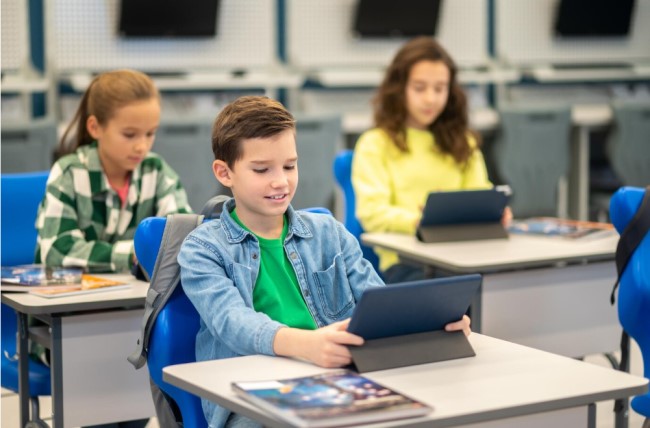AirDroid Business
- Application Management & Distribution
- Single & Multi-App Mode
- Kiosk Browser & Website Whitelist
- Policies for Device Limitation & WiFi Configuration
- Remote Access & File Transfer
- Geofencing & Tracking
- Device Monitoring & Alerts
MDM
The way that education is delivered in the modern era is constantly changing, and this includes how technology is incorporated into the classroom. According to recent statistics, there has been a notable shift towards digital tools, with nearly 40% of schools globally incorporating tablets into their curricula.
Imagine classrooms that are alive with interactive instruction, where the boundaries of traditional learning are blurred by a deep embrace of technology. This digital revolution invites active engagement in determining the direction of education going forward, going beyond a simple update. Accept the interaction, investigate options, and lead the way in the revolutionary movement that is changing the face of education.
In the realm of traditional education, the weight of textbooks poses a logistical challenge. Students often forget or misplace them, causing disruptions in the learning process.
Tablets emerge as a solution by providing a centralized platform for all educational materials. Real-time updates ensure students receive the latest information, eliminating the need for heavy backpacks and streamlining the learning experience. This transition not only enhances convenience but also keeps educational resources current and accessible, reflecting the evolving nature of knowledge in the digital age.
In a world of limited classroom time, teachers grapple with providing immediate feedback to every student. Enter tablets, bridging the gap by allowing for quick and efficient assessment. Students can receive instant feedback on their work, fostering a more responsive and personalized learning environment.
The transformative potential of real-time feedback lies not just in its speed but in its ability to create a dialogue between students and educators, enriching the learning experience with timely insights and guidance. This shift goes beyond evaluation; it cultivates a culture of continuous improvement and engagement.
Traditional teaching methods sometimes struggle to capture students' interest.
Tablets introduce interactive elements through educational apps, transforming learning into an enjoyable and engaging experience. This departure from conventional activities ensures that students remain motivated and active participants in the learning process.
From interactive simulations to gamified lessons, the possibilities are vast. By infusing joy into education, tablets not only make learning more appealing but also pave the way for a deeper understanding and retention of knowledge. Explore how the marriage of technology and engagement creates a dynamic and participatory learning atmosphere.

Tablets empower students to take control of their learning journey.
Unlike traditional tasks that demand constant teacher intervention, tablets promote self-learning. Students are encouraged to tackle assignments independently, fostering the development of crucial problem-solving skills.
This shift goes beyond the practicalities of task completion; it instills a sense of autonomy and responsibility in students. Dive into the transformative potential of tablets in shaping not just knowledgeable individuals but also independent thinkers and lifelong learners. The empowerment of self-directed learning extends beyond the classroom into real-world scenarios, preparing students for a future where adaptability and initiative are paramount.
In the digital age, the ability to search for information and explore diverse perspectives is invaluable. Tablets equip students with the tools to navigate the vast sea of information, promoting critical thinking and a deeper understanding of subjects beyond what is provided by teachers.
The development of information search skills isn't just about using search engines; it involves discernment, evaluation, and synthesis of information. It transforms students into active participants in the construction of knowledge. Explore how tablets become vessels for honing these skills, preparing students not just for academic success but for a world where information literacy is a key competency.
Beyond academic knowledge, tablets expose students to essential technical skills. From typing to using various software applications and understanding the basics of digital security and privacy, these skills are increasingly relevant in today's technology-driven society.
Delve into the world of digital competence that tablets introduce, shaping students not just as learners but as adept navigators of the digital landscape. As students engage with technology, they acquire skills that extend beyond the classroom into the professional realm. Explore how tablets become tools not just for academic achievement but also for equipping students with the digital prowess required in a rapidly evolving technological landscape.
Several tablet brands have gained popularity in educational settings, each offering unique benefits.
Tablets have emerged as powerful tools in the educational landscape, transforming classrooms and enriching learning experiences. Statistics paint a compelling picture of their growing impact.
According to the 2023 GEM Report by UNESCO, access to tablets in schools has surged globally, with developing countries witnessing a remarkable 69% increase between 2019 and 2021. This surge is echoed in the United States, where the National Center for Education Statistics reports that in 2021, 52% of public schools possessed tablets for student use, a significant jump from 39% in 2016.
Beyond mere presence, tablets are actively shaping learning.
The GEM Report highlights that over 70% of teachers globally use tablets for instructional purposes, integrating them into lessons to boost engagement and cater to diverse learning styles. Interactive apps, simulations, and multimedia content bring abstract concepts to life, fostering deeper understanding and critical thinking. This is particularly impactful for students with disabilities, as tablets offer accessibility features and personalized learning tools that cater to individual needs.
However, challenges remain.
The GEM Report points out that despite the rise in access, significant disparities persist between regions and socioeconomic backgrounds. Bridging the digital divide requires not just hardware provision but also robust infrastructure, reliable internet connectivity, and teacher training to effectively utilize these tools. Moreover, concerns regarding screen time, digital distractions, and equitable access to content necessitate careful consideration and responsible implementation.

Leave a Reply.